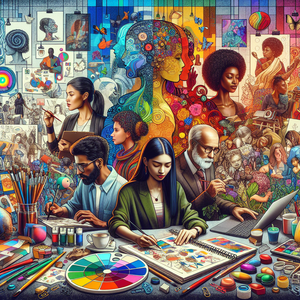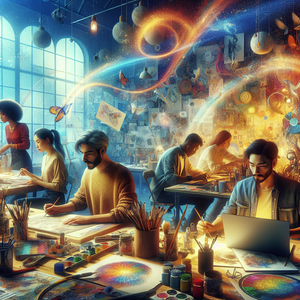
Navigating the Vibrant Landscape of Visual Arts Careers: From Graphic Design to Art Therapy
The visual arts field is an expansive realm filled with diverse career opportunities that cater to a variety of skills and passions. A degree in visual arts can serve as a gateway to numerous paths, each leading to distinct roles where creativity harmonizes with technology and commerce. With the growing demand for professionals in areas such as multimedia art, animation, and interior design, the job market is ripe for individuals seeking fulfilling and dynamic careers. Notably, art directors stand out in this landscape, enjoying high demand and lucrative salaries as they shape the visual direction of projects across various media.
Job Summaries:
Graphic Designer:
- Graphic designers are the architects of visual communication.
- They create compelling content that resonates across print and digital platforms.
- They wield design software like Adobe Creative Suite to produce layouts, logos, and marketing materials.
- Typically, a bachelor's degree in graphic design or a related field is essential.
- A robust portfolio that showcases their work is important.
- This role is critical in shaping brand identities and enhancing user experiences.
Art Director:
- Art directors are the visionaries behind the visual elements of projects in advertising, publishing, and other creative sectors.
- They manage design teams, collaborate closely with clients, and ensure that all visual components align with project objectives.
- A bachelor's degree in fine arts or a related discipline is often required, along with substantial design experience.
- This position holds considerable influence over branding and marketing strategies.
Multimedia Artist:
- Multimedia artists blend various artistic mediums, such as animation, video, and graphics, to create engaging digital content.
- They work in industries like entertainment, advertising, and gaming.
- They utilize software such as Adobe After Effects and Blender.
- A degree in animation, graphic design, or fine arts is generally necessary.
- A strong portfolio that demonstrates their skills is essential.
Art Therapist:
- Art therapists harness the power of artistic expression as a therapeutic tool.
- They help individuals confront emotional and psychological challenges.
- Art therapists find work in hospitals, schools, and private practices.
- They usually require a master’s degree in art therapy or a related field, along with certification.
- This role is vital for promoting mental health through creative processes.
Interior Designer:
- Interior designers create both functional and aesthetically pleasing environments in residential and commercial spaces.
- They engage with clients to understand their needs.
- They develop design concepts and select materials.
- A degree in interior design or architecture is usually essential.
- Familiarity with building codes is important.
Animator:
- Animators craft moving images and visual effects for films, video games, and online content.
- They merge artistic talent with technical proficiency in software, creating animations that tell stories or convey information.
- A degree in animation or a related area is generally required.
Fine Artist:
- Fine artists create original artworks, such as paintings, sculptures, and illustrations.
- They often work for galleries or private commissions.
- They need a strong technical skill set and a unique artistic vision.
- Artistic skills are typically honed through a bachelor’s or master’s degree in fine arts.
Fashion Designer:
- Fashion designers are responsible for creating clothing, accessories, and footwear that marry aesthetic appeal with functionality.
- They research trends, sketch designs, and work with textiles to bring their concepts to life.
- A degree in fashion design or a related field is usually necessary.
Art Curator:
- Art curators manage collections in galleries, museums, and institutions.
- They select pieces for exhibitions.
- They conduct research.
- They educate the public about art.
- A master’s degree in art history or museum studies is often required.
- Relevant experience is often necessary.
Photographer:
- Photographers capture images that tell stories or convey messages.
- Photographers may operate in a variety of fields, including portrait, commercial, and event photography.
- A degree in photography or visual arts is beneficial.
- A strong portfolio and practical experience often carry more weight.
Illustrator:
- Illustrators create images that visually depict concepts for books, magazines, or advertisements.
- They employ various techniques, both digital and traditional, to bring their visions to life.
- Typically, a degree in illustration or fine arts is required.
UX/UI Designer:
- User Experience (UX) and User Interface (UI) designers craft engaging digital experiences.
- They achieve this through user research, prototype design, and collaboration with developers.
- A degree in design, human-computer interaction, or a related field is often necessary.
Art Editor:
- Art editors oversee the visual elements of publications.
- They ensure that images and designs align with the publication's aesthetic.
- They often hold a degree in graphic design or visual arts.
Set Designer:
- Set designers create physical environments for theater, film, and television productions.
- They collaborate closely with directors to establish visual aesthetics.
- A degree in theater design or fine arts is often required.
Environmental Artist:
- Environmental artists produce site-specific works that interact with the landscape.
- They often address ecological and social issues.
- They typically have a strong background in fine arts.
- They possess knowledge of environmental design principles.
Exhibition Designer:
- Exhibition designers create engaging displays for museums and trade shows.
- Focus on layout and visitor experience.
- A background in design or architecture is generally required.
Jewelry Designer:
- Jewelry designers craft unique wearable art pieces using precious metals and stones.
- They often need a degree in jewelry design or a related field, along with strong design skills.
Visual Merchandiser:
- Visual merchandisers design eye-catching displays in retail spaces to enhance the shopping experience.
- A background in marketing or visual arts is often beneficial.
Medical Illustrator:
- Medical illustrators create detailed visual representations for educational purposes in healthcare.
- A degree in medical illustration or a related field is typically required.
- Strong drawing skills are typically required.
Calligrapher:
- Calligraphers specialize in beautiful writing.
- Creating custom invitations and decorative pieces.
- A deep understanding of lettering techniques is essential.
- Often developed through practice and study.
This exploration of visual arts careers highlights the myriad opportunities available for those passionate about creativity. Each role contributes significantly to cultural narratives and enhances our visual experiences. Whether your interests lie in design, therapy, or fine arts, a fulfilling path awaits you in this exciting field. By understanding the various career options, educational requirements, and market trends, aspiring professionals can embark on their journey in the vibrant world of visual arts with confidence and enthusiasm.
Explore More Jobs

